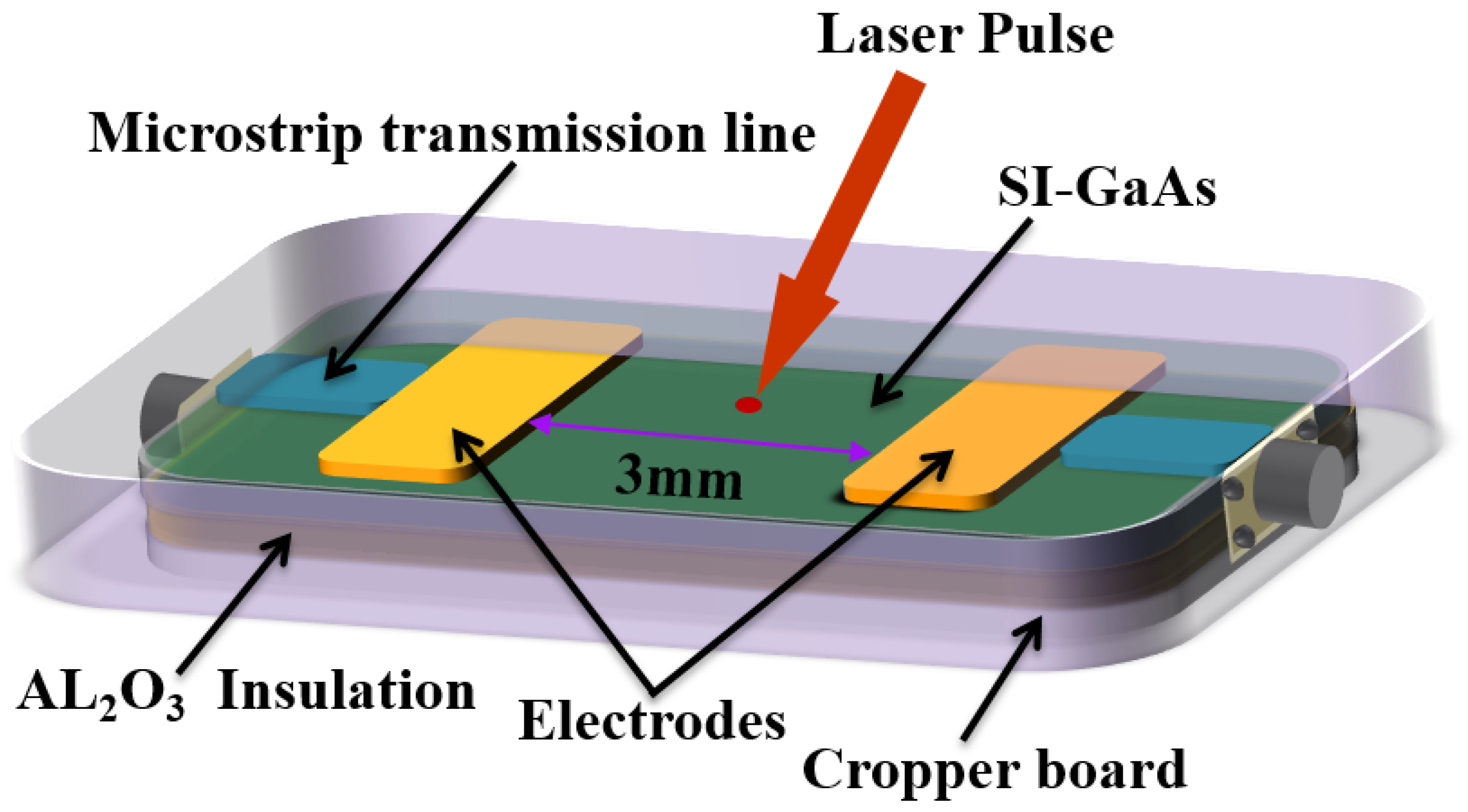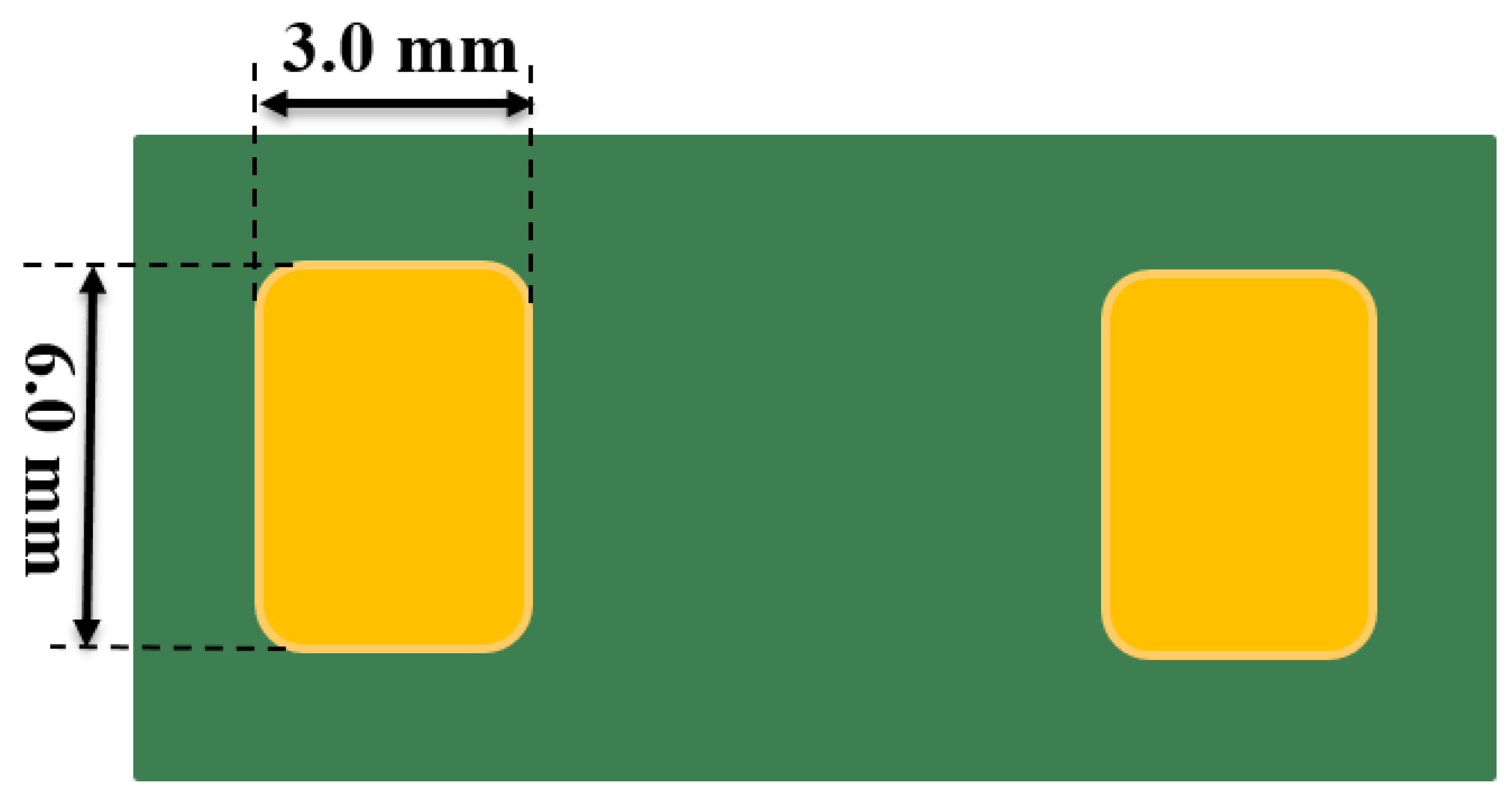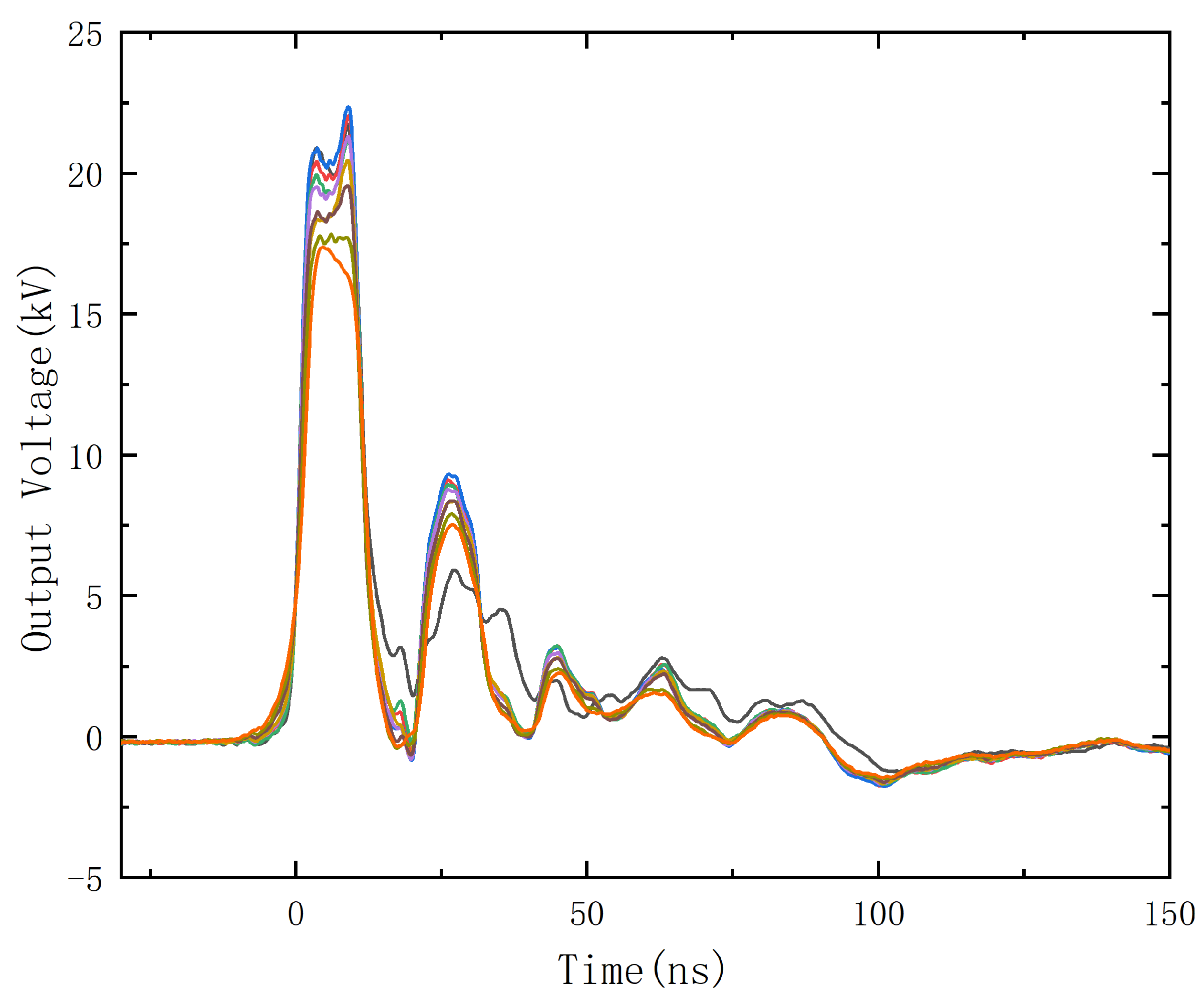Pulse Width Control Based on Blumlein Pulse Forming Line and SI-GaAs PCSS
Abstract
:1. Introduction
2. Experimental Setup
2.1. SI-GaAs PCSS
2.2. Test Circuit
3. Results and Discussion
4. Conclusions
Author Contributions
Funding
Institutional Review Board Statement
Informed Consent Statement
Data Availability Statement
Conflicts of Interest
References
- Ajram, S.; Salmer, G. Ultrahigh frequency DC-to-DC converters using GaAs power switches. IEEE Trans. Power Electron. 2001, 16, 594–602. [Google Scholar] [CrossRef]
- Chang, C.; Liu, G.; Tang, C.; Chen, C.; Fang, J. Review of recent theories and experiments for improving high-power microwave window breakdown thresholds. Phys. Plasmas 2011, 18, 055702. [Google Scholar] [CrossRef]
- Vergne, B.; Couderc, V.; Barthélémy, A.; Gontier, D.; Lalande, M.; Bertrand, V. High-voltage rectifier diodes used as photoconductive device for microwave pulse generation. IEEE Trans. Plasma Sci. 2006, 34, 1806–1813. [Google Scholar] [CrossRef]
- Wang, W.; Xia, L.; Chen, Y.; Liu, Y.; Yang, C.; Ye, M.; Deng, J. Research on synchronization of 15 parallel high gain photoconductive semiconductor switches triggered by high power pulse laser diodes. Appl. Phys. Lett. 2015, 106, 022108. [Google Scholar] [CrossRef]
- Shi, W.; Zhang, L.; Gui, H.; Hou, L.; Xu, M.; Qu, G. Accurate measurement of the jitter time of GaAs photoconductive semiconductor switches triggered by a one-to-two optical fiber. Appl. Phys. Lett. 2013, 102, 154106. [Google Scholar] [CrossRef]
- Schoenberg, J.S.; Burger, J.W.; Tyo, J.S.; Abdalla, M.D.; Skipper, M.C.; Buchwald, W.R. Ultra-wideband source using gallium arsenide photoconductive semiconductor switches. IEEE Trans. Plasma Sci. 1997, 25, 327–334. [Google Scholar] [CrossRef]
- Nunnally, W.C. High-power microwave generation using optically activated semiconductor switches. IEEE Trans. Electron Devices 1990, 37, 2439–2448. [Google Scholar] [CrossRef]
- Islam, N.; Schamiloglu, E.; Fleddermann, C.; Schoenberg, J.; Joshi, R. Analysis of high voltage operation of gallium arsenide photoconductive switches used in high power applications. J. Appl. Phys. 1999, 86, 1754–1758. [Google Scholar] [CrossRef]
- Auston, D.H. Picosecond optoelectronic switching and gating in silicon. Appl. Phys. Lett. 1975, 26, 101–103. [Google Scholar] [CrossRef]
- Lee, C.H. Picosecond optoelectronic switching in GaAs. Appl. Phys. Lett. 1977, 30, 84–86. [Google Scholar] [CrossRef]
- Merla, C.; El Amari, S.; Kenaan, M.; Liberti, M.; Apollonio, F.; Arnaud-Cormos, D.; Couderc, V.; Leveque, P. A 10-Ω High-Voltage Nanosecond Pulse Generator. IEEE Trans. Microw. Theory Tech. 2010, 58, 4079–4085. [Google Scholar] [CrossRef]
- Shi, W.; Wu, M.; Ma, C.; Chen, Z. Pulse width Control of Nonlinear GaAs Photoconductive Semiconductor Switch. IEEE Trans. Electron. Devices 2022, 69, 4396–4400. [Google Scholar] [CrossRef]
- Mi, Y.; Zhang, Y.; Wan, J.; Yao, C.; Li, C. Nanosecond pulse generator based on an unbalanced blumlein-type multilayered microstrip transmission line and solid-state switches. IEEE Trans. Plasma Sci. 2016, 44, 795–802. [Google Scholar] [CrossRef]
- Wang, L.; Liu, J.; Zhang, Q. Effect of different environmental dielectrics on the pulse-forming characteristics of solid-state meander pulse-forming line. IEEE Trans. Plasma Sci. 2016, 44, 821–828. [Google Scholar] [CrossRef]
- Geng, Y.; Zou, H.; Li, C.; Sun, J.; Wang, H.; Wang, P. Short pulse generation with on-chip pulse-forming lines. IEEE Trans. Very Large Scale Integr. VLSI Syst. 2011, 20, 1553–1564. [Google Scholar] [CrossRef]
- Ma, C.; Yang, L.; Wang, S.; Ji, Y.; Zhang, L.; Shi, W. Study of the lifetime of high-power GaAs PCSSs under different energy storage modes. IEEE Trans. Power Electron. 2016, 32, 4644–4651. [Google Scholar] [CrossRef]
- Xiao, L.; Hu, X.; Chen, X.; Peng, Y.; Yang, X.; Xu, X. Effect of periodic array on the on-state resistances of GaAs photoconductive semiconductor switch based on total reflection theory. AIP Adv. 2017, 7, 065119. [Google Scholar] [CrossRef] [Green Version]







Disclaimer/Publisher’s Note: The statements, opinions and data contained in all publications are solely those of the individual author(s) and contributor(s) and not of MDPI and/or the editor(s). MDPI and/or the editor(s) disclaim responsibility for any injury to people or property resulting from any ideas, methods, instructions or products referred to in the content. |
© 2023 by the authors. Licensee MDPI, Basel, Switzerland. This article is an open access article distributed under the terms and conditions of the Creative Commons Attribution (CC BY) license (https://creativecommons.org/licenses/by/4.0/).
Share and Cite
Wu, M.; Shi, W.; Ma, C.; Chen, Z.; Liu, H. Pulse Width Control Based on Blumlein Pulse Forming Line and SI-GaAs PCSS. Photonics 2023, 10, 156. https://doi.org/10.3390/photonics10020156
Wu M, Shi W, Ma C, Chen Z, Liu H. Pulse Width Control Based on Blumlein Pulse Forming Line and SI-GaAs PCSS. Photonics. 2023; 10(2):156. https://doi.org/10.3390/photonics10020156
Chicago/Turabian StyleWu, Meilin, Wei Shi, Cheng Ma, Zhiyuan Chen, and Hui Liu. 2023. "Pulse Width Control Based on Blumlein Pulse Forming Line and SI-GaAs PCSS" Photonics 10, no. 2: 156. https://doi.org/10.3390/photonics10020156





